Tuesday Jan 20, 2026
Tuesday Jan 20, 2026
Tuesday, 30 May 2023 00:00 - - {{hitsCtrl.values.hits}}

By Great Place to Work in Sri Lanka
A pivotal role in the country’s economy and the future
The information technology (IT) and IT-enabled services (ITES) sectors in Sri Lanka play a crucial role in driving the country's economic growth, technological advancement and generating employment opportunities.
As the 3rd highest export revenue earner for Sri Lanka, the ICT sector reached $ 1.5 billion in 2022 with a workforce of over 150,000 employees (SLASSCOM, 2023). With over 90% value addition and high paying jobs, has made a significant impact on the growth of the Sri Lankan Economy (SL EDB, 2022). Over a decade, the segment grew by 300% (ICTA, 2022), to become a sought-after hub for R&D, BPOs and other consultancy services catering to the US, AUS and Western Europe. The Sri Lankan IT/ITES industry is characterised by its skilled workforce, competitive operational cost structure, English language proficiency and Government support to grow the sector.
Though moving slow, Sri Lanka is on a path towards digital transformation. The pandemic, albeit a global tragedy, heavily depended on the segment for the world to function in some semblance of normalcy leading to exponential growth and fast adaptations in the sector to supply the demand. However, 2022 saw Sri Lanka amidst political turmoil and an economic crisis that contributed to a 0.3% marginal contraction (CBSL, 2022). Focus is on the industry to reset and reach $5 billion revenue by 2025 (SLASSCOM, 2023). Considering the importance of this industry Great Place to Work in Sri Lanka conducted a study into the people practices and employee perception around workplace culture for the 4th consecutive year
Study summary
During this year’s study cycle, over 6500 employees from the industry were surveyed with an average response rate of 81%. This study data helped to determine the 10 Best Workplaces in the IT/ITES industry who create an overwhelmingly positive and consistent workplace experience across the organisation. Organisations that were Great Place to Work Certified™ from April 2022 to April 2023 were considered for this study.
Methodology for selecting the Best Workplaces
Great Place to Work is the globally recognised authority on studying and identifying Best Workplaces. Over the past 30+ years it has studied Great Workplaces and expanded its reach to over 150 countries and territories. Organisations utilise services to benchmark, understand key strengths and areas to improve on and act to drive workplace culture that supports organisational performance. The Sri Lankan study is based on the global model and a rigorous methodology, which has been researched, tested, and carried out in similar studies worldwide.
The selection follows the global ‘Great Place to Work For All’ methodology. 85% of the evaluation is based on the experience of trust and employees reaching their full human potential as part of their organisations – no matter who they are or what they do. These experiences are analysed in relation to each company’s size, workforce demographics and industry norms.
The remaining 15% of the evaluation is based on all employees’ daily experiences of innovation, their organisations’ values, and the effectiveness of their leaders to ensure a consistent positive experience.
The measurement tool used to assess workplace culture is based on two lenses; Firstly, the Trust Index employee perception survey is conducted to understand the employee workplace experience and constitutes 75% of the total organisation score.
In Sri Lanka, only organisations certified (for a period of 1 year) as a Great Workplace with more than a 70% minimum positive employee perception are considered for Best Workplaces studies in that year. Organisations are measured on whether employees trust the people they work for, have pride in work they do and share camaraderie among people they work with.
Secondly, the practices and processes in place to drive the employee experience are evaluated through a central submission termed the Culture Audit which constitutes the remainder 25% of the total score.
Results for each of the listed organisations are audited to maintain accuracy and validity of its inclusion in the Best Workplaces List.
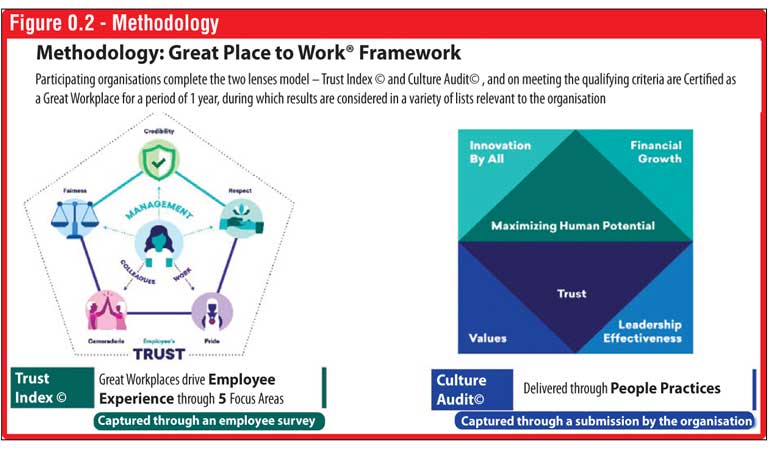

Results overview
Figure 1 is a comparison of the Trust Index (TI) average employee positive perception in the Best 10 IT/ITES industry against key benchmarks.
The TI was measured across 58 core global statements and provides an ‘analytical viewpoint’ of an employee. It is encouraging that the Best 10 SL outperform all benchmarks. It is noteworthy that even though certain areas have fluctuated, the overall average among the Best 10 has remained the same from last year.
Key focus areas
The Trust Index is segmented into 5 key focus areas which are displayed in Figure 2. While fairness fares the lowest as the norm, it is camaraderie and not pride that is perceived with the highest positivity among employees. ‘Intimacy’ (94%) or the ability to be oneself at work: a sub area of camaraderie, and a sense of social justice (95%) or lack of discrimination based on demographics: a sub area under fairness, are the highest areas in the study indicating that the current environment in IT/ITES workplaces are supporting these needs well.
Demographic highlights
Overall average perception was similar by gender among the Best 10, with female positivity being 1 percentage point higher than males. The number of females respondents was 41% among the Best 10 and 32% among the rest. The biggest gaps in perception were clarity of organisation direction, collaboration and unique benefits for males and empowerment, seeing cooperation and discretionary effort for females. A significantly lower positive perception was noted among long tenured employees (+20 years) and the oldest age group (+55 years) among the Best 10 highlighting the need for action in addressing these groups.

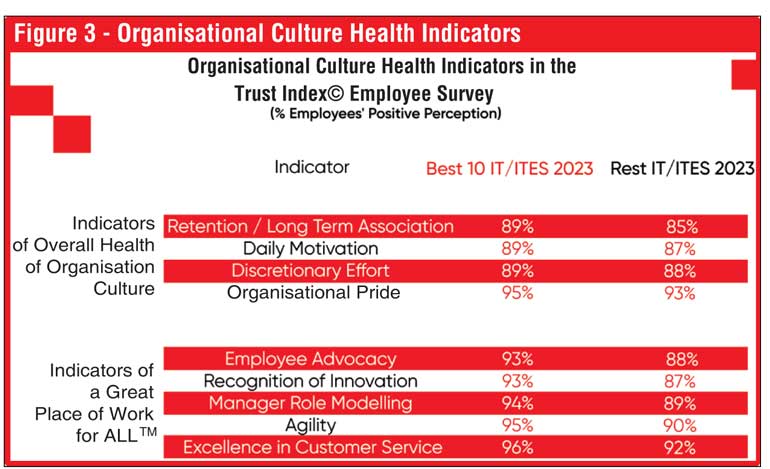
Health indices for organisational culture
Figure 3 highlights the key indices of a healthy organisational culture and being a ‘Great Workplace For All’. Overall participating organisations in the study showed a strong base in trust and the gaps are narrow.
The Best 10 perform significantly better than the rest in terms of employees’ engagement by long-term association and advocacy of the organisation. A solid foundation across the health indices supports employees in maximising their potential and owning one’s function to deliver the best. Since employees of the IT/ITES industry mostly work remotely it is important that they be self-motivated to perform tasks, but also be supported by their people managers and teams to function the way they do.
Where the Best 10 outperform the rest
Figure 4 displays the highest gaps between the Best 10 and the rest in the study, comparing the top differentiators in the survey. Overall, the Best outperforms the rest by 4 percentage points on average.
While it was not the lowest scoring area, the biggest gap in perception is in the work environment maintained, where employees among the Best in IT/ITES perceive less toxic behaviour in the workplace. This is a benefit of a foundation of trust and it’s key to maintaining daily motivation at work and igniting the benefits of the ‘speed of trust’ among teams. It is also noteworthy that the areas where the biggest gaps are seen are also the key indicators of a ‘Great Place to Work For All’ culture.
Key Drivers of employee perception
Key Drivers are the specific areas from the Trust Index that are linked to employees considering their workplaces as great. Perception in these areas drives the long-term emotional connection with the organisation. Manager role modelling, Managers walking the talk, Egalitarian treatment, Managers demonstrating sincere care, were the key drivers of perception for employees of Best 10. It is significant to observe that they are linked to managerial behaviour. Since employees are promoted to managers based on their personal performance, it’s vital to have team leads trained in managing people to have them deliver performance through a team.
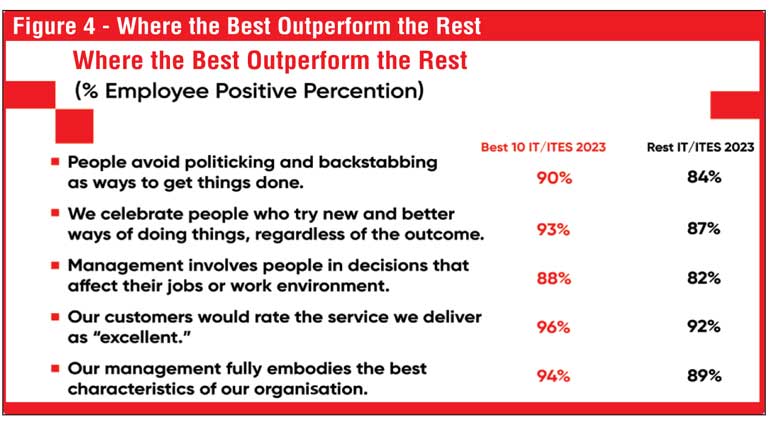
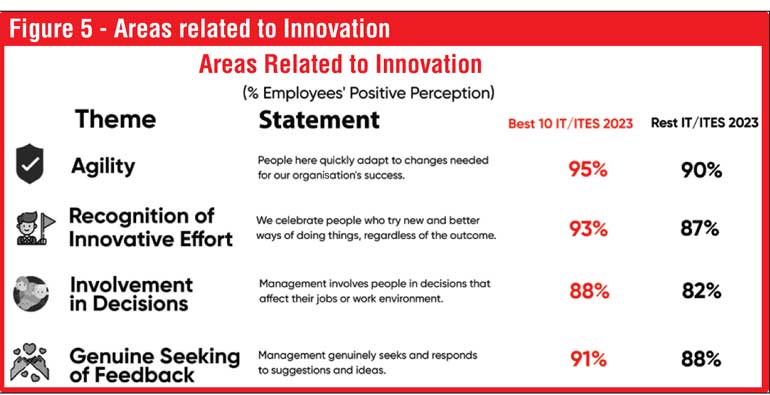
A key output of maximising human potential: Innovation by All
Great Place to Work measures what can be considered the roots of an innovative culture shown in figure 5. There is a significant gap between Best vs. rest in these areas. Organisations looking to build innovative cultures need to focus on proactively stimulating an environment which supports the daily inventive process in incremental steps.
A collaborative approach should be maintained by managers to harness knowledge workers. Employees’ efforts at innovation call for recognition regardless of the outcome to truly set the groundwork for moving out of one’s comfort zone and taking a risk that can lead to a future innovation.
Striving for excellence: Areas for improvement
External pride in organisation, agility of people, manager business acumen, team spirit, good facilities and opportunities for training are strengths identified among the Best 10.
The areas of key concern among employees of even the Best 10 are shown in Figure 6. While the Best certainly outperform the rest in these areas, there is still much need for improving employee perception.
The number one area of concern even among the Best 10 is compensation and benefits. It can be assumed that the external economic stresses in the country play a significant role in this perception. This also influences perception around performance management as employees' focus is around fairness and promotions for career progression. This highlights the need for organisations to ensure all employee rewards are fairly linked to performance and all employees can contribute and have access to opportunities.
Conclusion
It emerges that an organisation needs to take an integrated approach regarding managing human capital including hiring adaptable people who fit culture, fostering a culture of teamwork to support during tough times and trustworthy leadership to lead the way.
The Sri Lankan economic crisis placed great burdens among the IT/ITES industry that lead to firefighting; heavy migration overseas left remaining employees picking up the slack; Inflation in cost of living added to frustrations and isolation through working remotely along with a heavier workload took a toll on work-life balance.
However, thorough it all, it was noted that delivery and productivity were maintained, showing the industry to be resilient. Great workplaces are evolving to better support the need for employee wellbeing initiatives as well as a result and Great Place to Work in Sri Lanka has evolved along with this need to help organisations measure employee perception on same.
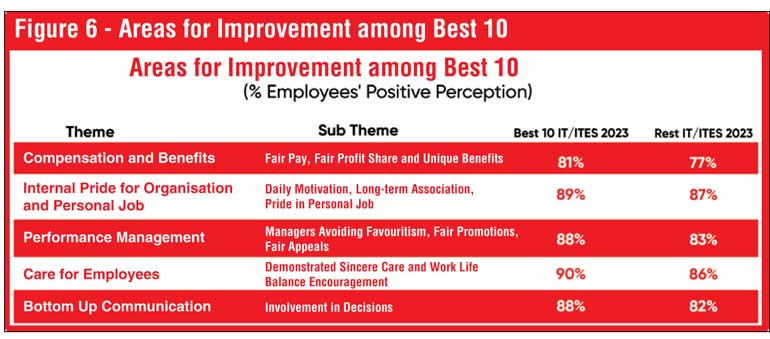
Studies have established that great workplace culture is the number one organisational strategy for attracting and retaining great talent in the IT/ITES industry. Continuous assessment supports employers to gather feedback and sustain practices that drive performance. These findings have contributed to identifying areas within the sector that can be used to better articulate industry specific strategies, highlight competence and best practices and enhance investor attractiveness in the sector.
Great Place to Work’s mission is to help every place become a Great Place to Work For All so that organisations can maximise human potential through a high-trust high-performance culture that drives business, improves lives, and creates a better society. No matter where you are in your journey, you are invited to join in to discover and drive your employee's positive perception and contribute to achieving the vision of making Sri Lanka a great place to work.
For more information: Contact Isurika Bandara
| [email protected]| 0743551750
Or Great Place to Work in Sri Lanka
| +94 114 545 594 | www.greatplacetowork.lk